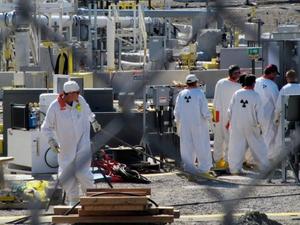Nuclear wasteRadioactive leaks at Washington’s Hanford nuclear reservation
Earlier this month, Washington Governor Jay Inslee announced that a radioactive waste tank at one of the nation’s most contaminated nuclear sites is leaking, bringing more bad news to Washington’s Hanford nuclear reservation. The 177 tanks at the plant, which hold millions of gallons of highly radioactive waste from plutonium production, are way past their intended 20-year life span.

Hazmat crew preparing for cleanup // Source: fanthai.com
Earlier this month, Washington Governor Jay Inslee announced that a radioactive waste tank at one of the nation’s most contaminated nuclear sites is leaking, bringing more bad news to Washington’s Hanford nuclear reservation.
The news has put more pressure on the federal government to deal with construction issues at Hanford nuclear reservation. The Christian Science Monitor reports that the tanks at the plant, which hold millions of gallons of highly radioactive waste from plutonium production, are way past their intended 20-year life span.
Inslee said the state was assured a long time ago that problems such as this had been solved years ago. He also noted that upcoming government spending cuts could make things worse at the reservation.
Earlier this month, the U.S. Department of Energy said the liquid levels are dropping in one of the 177 underground tanks at the site. While radiation levels have not increased, according to those monitoring the situation, the leak could be a long-term threat to groundwater and rivers.
The tank, which was built in the 1940s, contains about 447,000 gallons of sludge. The tank has leaked in the past but was fixed in 1995. According to Inslee, this is the first leak since all the tanks were stabilized in 2005. Inslee plans on traveling to Washington, D.C. next week to discuss the problem further.
“I am alarmed about this on many levels,” Inslee said at a news conference. “This raises concerns, not only about the existing leak … but also concerning the integrity of the other single shell tanks of this age.”
According to Inslee, Energy Secretary Steven Chu is committed to the cleanup, but he is concerned about Congress’ commitment to clean up the site.
Many of the tanks need to be drained as they have leaked over time and poured an estimated one million gallons of waste, threatening groundwater and the Columbia River, the largest waterway in the Pacific Northwest.
In addition to the outdated tanks and the leaks, a $12.3 billion plant that is supposed to convert the waste to a safe stable form is years behind schedule. Technical issues have put the project on hold and workers have filed lawsuits, saying they were retaliated against after raising concerns about the design and safety of the plant.
“We’re out of time, obviously. These tanks are starting to fail now,” Tom Carpenter of the Hanford watchdog group Hanford Challenge told the Christian Science Monitor. “We’ve got a problem. This is big.”
